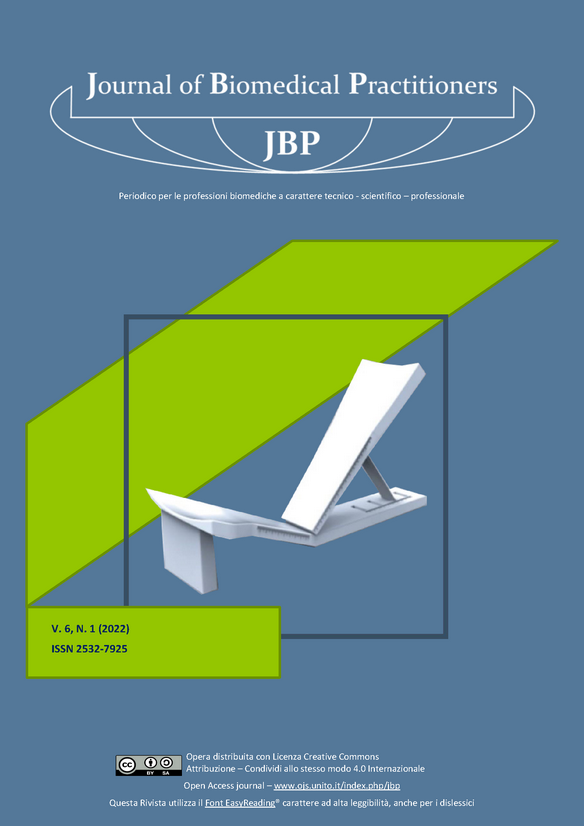L’utilizzo di dispositivi ad alto flusso durante le manovre assistenziali nei pazienti (adulti ricoverati) con infezione da SARS-CoV-2: uno studio di coorte retrospettivo.
Contenuto principale dell'articolo
Abstract
INTRODUZIONE
Il 14% dei pazienti con infezione da SARS-CoV-2 progredisce verso l'insufficienza respiratoria ipossiemica che richiede ossigenoterapia. L’obiettivo dello studio è quello di valutare l’efficacia e la sicurezza dell’ossigeno nasale ad alto flusso (HFNC) durante le manovre assistenziali (igiene personale, cura del sé e alimentazione) nei pazienti con infezione da SARS-CoV-2.
MATERIALI E METODI
Con disegno di studio coorte retrospettiva in tre reparti subintensivi dell’Azienda Sanitaria Locale di Asti dal 8 Novembre 2020 al 20 Gennaio 2021, è stata esaminata la documentazione di pazienti dai 41 ai 100 anni con infezione da SARS-CoV-2 che utilizzavano gli HFNC durante le manovre assistenziali alternati al casco/maschera CPAP. Per la ricerca del campione è stato utilizzato il programma Dshop® in cui sono state raccolte le età, le percentuali di FiO2 e i cmH2O di PEEP somministrate alle persone assistite e sono stati rilevati i parametri di ventilazione. È stata effettuata un’analisi statistica di tipo inferenziale.
RISULTATI
Dall’analisi di 536 cartelle cliniche 114 sono state inserite nello studio. È emersa una riduzione significativa della pO2 e del rapporto pO2/FiO2 e una diminuzione della SpO2 nella fascia di età più anziana del campione [91-100] durante l’utilizzo di HFNC. Per quanto riguarda la FiO2 è stata mostrata una riduzione significativa della SpO2 e del P/F con la somministrazione di FiO2 del 90-100%. Infine, con l’HFNC i valori di HCO3 e lattati sono contenuti nei valori ottimali dell’EGA a differenza del casco/maschera CPAP con PEEP di 15 cmH2O.
DISCUSSIONE E CONCLUSIONI
L'HFNC è associato ad un maggiore comfort infatti il paziente può idratarsi, alimentarsi, eseguire l’igiene e la cura del sé in autonomia. La modalità ventilatoria CPAP richiede, invece, una spiccata collaborazione uomo-dispositivo, i pazienti spesso risultano essere ansiosi, claustrofobici e non aderenti.
Downloads
Dettagli dell'articolo
Gli autori mantengono i diritti sulla loro opera e cedono alla rivista il diritto di prima pubblicazione dell'opera, contemporaneamente licenziata sotto una Licenza Creative Commons - Attribuzione che permette ad altri di condividere l'opera indicando la paternità intellettuale e la prima pubblicazione su questa rivista.
Riferimenti bibliografici
[2] Procopio, G Cancelliere, G e Trecarichi, EM. (2020). “Oxygen therapy via high flow nasal cannula in severe res-piratory failure caused by Sars-Cov-2 infection: a real-life observational study”. Ther Adv Respir Dis, 14-7.
[3] World Health Organization. “WHO Coronavirus (COVID-19) Dashboard With Vaccination Data [Internet]”. WHO Coronavirus (COVID-19); 11 agosto 2021 [consultato l'11 agosto 2021]. Disponibile all'indirizzo: https://covid19.who.int/.
[4] Geng, S Mei, Q e Zhu, C. (2020). “High flow nasal cannula is a good treatment option for COVID-19”. Heart Lung, 49(5), 444-5.
[5] Asta M. “Covid. Casco VS ossigeno nasale ad alti flussi. Studio italiano sull'efficacia”. Infermieristicamente Nur-sid [Internet]. 29 marzo 2021 [consultato il 24 luglio 2021]. Disponibile all'indirizzo: https://www.infermieristicamente.it/articolo/13566/covid-casco-vs-ossigeno-nasale-ad-alti-flussi-studio-italiano-sullefficacia
[6] Papachatzakis, Nikolaidis e Kontogiannis, S. (2020). “High-Flow Oxygen through Nasal Cannula vs. Non-Invasive Ventilation in Hypercapnic Respiratory Failure: A Randomized Clinical Trial”. Int J Environ Res Public Health, 17(16) 5994.
[7] Parke, RL e McGuinness, SP. (2013). “Pressures Delivered By Nasal High Flow Oxygen During All Phases of the Respiratory Cycle”. Respir Care, 58(10), 1621-24.
[8] Cosimo, F Facciolongo, N e Tonelli, R. (2020). “Feasibility and clinical impact of out-of-ICU noninvasive respira-tory support in patients with”. Eur Respir J, 56(5), 2002130.
[9] Suhail, R Nava, S e Carpati, C. (2020). “High-Flow, Noninvasive Ventilation and Awake (Nonintubation) Proning in Patients With Coronavirus Disease 2019 With Respiratory Failure”. Chest, 158(5), 1992-2002.

